Positive Health Online
Your Country

Havening: A New Way To Heal
by Gina Pickersgill(more info)
listed in nlp, originally published in issue 211 - January 2014
Havening is a process designed to eliminate the consequences of maladaptive emotional memories. Post–havening the response to an emotional trigger is averted or eliminated. In particular it is very effective in removing phobia’s traumatically encoded memories, pathological emotions, anxiety, grief, somatic pain and many other conditions.
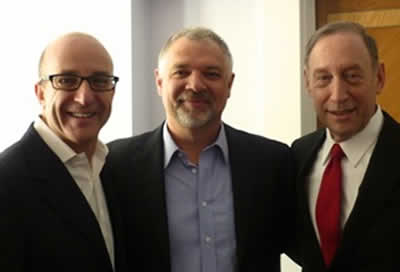
Paul McKenna, Steve Crabb and Ron Ruden
Origin
Havening (see www.havening.org ) was created by Dr Ronald Ruden, an internal medicine practitioner and theorist in the USA with his own clinical practice and client base. He was introduced to the idea of tapping technologies, such as EFT and TFT by hypnotist and personal development guru, Paul Mckenna. During his research on these technologies it was realized that for an event (Event Havening), simple touch and distracting techniques could produce relief from a client’s distressing memories. The mechanism proposed was the elimination (in medical terms, depotentiation) of receptors on part of the brain called the amygdala. It was this removal that literally disconnects the recalled memory from its emotional content, thus detaching the individual from the event. His training CD explains many of the cases where traumas have been reduced to insignificant levels using a Subjective Units of Distress (SUD) scale. In addition, other Havening Techniques were developed including one that instils new positive ways of thinking. It is called Affirmational Havening.
Event Havening consists of three main components:
- Activation of an emotional event by recall;
- Havening touch which is applied to the arms, face and palm;
- Distraction techniques such as visualizing and counting.
These three components when applied alter the brain waves to allow for the receptor to become internalized and thus block any response. The details are in Dr Ruden’s book When the Past is Always Present.
The question of how havening touch affects the brain to produce this effect led to research on everything from Traditional Chinese medicine and their acupuncture sites to the neurobiology of traditional extinction techniques. This led to an understanding that all sensory input could affect the brain, and the field of Psychosensory therapy was born. Through his research he created havening - meaning to take someone to a place of safety. The havening touch itself - soothing, calming and rhythmic, produces an extrasensory (above that of the touch receptors) response which drives the elimination of the receptor at the beginning of the encoded pathway.
The Havening Process
For problems such as simple phobias, havening achieves results that are rapid, gentle and permanent, sometimes in just minutes. Transformation does not require belief in the efficacy. This process can be done content free from the practitioner's point of view thus making it easy to solve client issues that may not have otherwise been dealt with using talking therapies or pharmacological intervention. Having said that, it can be easily bolted on to existing therapies for which you have already developed skill sets. A skilful practitioner will be able to flexibly combine the different Havening Techniques to give the best results. Indeed, the requirements for becoming a certified practitioner are that some previous training in NLP, hypnosis, psychology or counselling has been undertaken.
Case Study - Cat Phobia - KFM
I had been suffering from a fear of cats for around 28 years; for as long as I can remember I have always been anxious around cats, didn’t particularly like them and tried to avoid them when I could.
Throughout the years, the fear grew deeper and deeper in that I was constantly wondering if I was going to see a cat if I went out, what would it do to me and how could I avoid it.
At its worst, my fear stopped me from opening my windows in the house in case a cat jumped in. I wouldn’t go into my garden if a cat was there; I would either run back into the house if a cat came into the garden when I was out, or freeze on the spot. On a few occasions I have actually been brought to tears when a cat came into the same room as me.
I constantly thought the cat was going to attack me; it was terrible. I lived my life scanning for cats where ever I went and it was getting to the point where I would check if cats were going to be there before I would go anywhere.
Although I knew the fear was silly and the cat wouldn’t hurt me, I couldn’t stop the reactions I had. It was when I almost decided not to go on holiday as there would be feral cats that I decided enough was enough and booked a session.
The session was great: around 3 hours of talking and mental exercises which are quite easy but difficult to describe. Thinking about the different situations I had been in how they made me feel them turning these situations around in my head. I felt the session was really relaxing, with the dogs being there as support too.
At the end of the session the therapist asked me if I wanted to be introduced to her cat. Initially the immediate thought in my head was really !!!! but I agreed as I wanted to and she slowly but surely brought the cat into the room. In no time at all, I was petting her cat and the cat was roaming freely around the room.
I seriously would never have thought that by the end of the session I could have been in that place and able to do what I did. I also then started to wonder if this would last and get better; I desperately wanted it to.
I went home; my family could not believe the pictures from the session and they too wondered if it would work in our own environment. It was just a few days later that I went to my next door neighbour’s house and was able to sit on her sofa and clap her cat who previously stopped me from going in and out my house.
Since then I have been in a few houses with cats or had cats in my garden and I can honestly say I have had no reaction to them at all; I would and have quite easily petted them if they came up to me.
All my friends and family are completely in awe of the difference that the session has made to me and said if they hadn’t seen the difference with their own eyes they would never have believed that it worked.
Thank you for giving me my freedom back.
The Results
Successful Havening typically results in the client feeling very relaxed and at peace together with memory retrieval of the traumatic event being either fuzzy or incomplete, unable to access it at all, or some positive replacement in the form of a metaphorical solution. The trials and tribulations of clients’ lives have long been a bone of contention, in that overcoming problems has been the focus of therapy for many years. As with all new technologies we find faster and better ways to get results that really do make a difference. This is one of the times where what we thought was unobtainable is now totally accessible via Havening touch methodologies.
Tony Burgess, a qualified practitioner was able to help his client online. Here is a testimonial:
“Thank you so much for our session via Skype when you taught me The Havening Technique. I had been feeling so overwhelmed by several recent events in my life, and as a result I had no energy or motivation to deal with my day-to-day challenges. Even though I have some tools of my own which I could have used, I was feeling too overwhelmed. I could not see the wood for the trees and I felt as though I was dragging myself through treacle every day. As a result I was achieving nothing and feeling very frustrated.
However, after two hours working with you, learning and using this amazing technique, I felt calm, relaxed and peaceful for the first time in a very long time, and totally free of the feeling of being overwhelmed. I felt I could finally start to move forward again!
Since then I have used the technique to ‘top up’ what we worked on, and now I’m making some much needed life changes at last! I feel energized and motivated again, and I am totally free of the treacle too! I think everyone should learn this technique with you!”
Although it is recommended that Havening be conducted by a qualified practitioner (Facilitated) for more complex issues, Self-Havening can also be done quite successfully. Follow the process below.
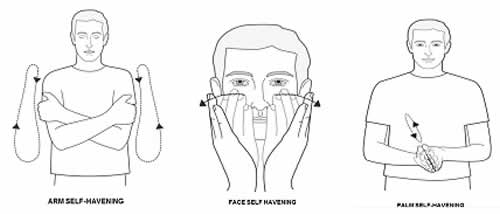
Images used with the express permission of Dr Ronald Ruden
Self-Havening Touch Process
Self-Havening can be very effective if done with discipline, insight and a willingness to take risks to bring up uncomfortable emotions. Common conditions that respond particularly well are acute strong negative emotions, such as anger, grief, jealously and sadness, compulsive thoughts and behaviours such as hair pulling, and or imaging stressful situations, general anxiety, panic attacks and chronic somatic pain.
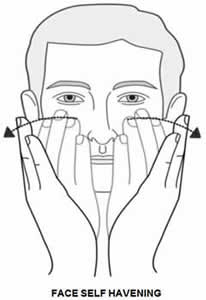 |
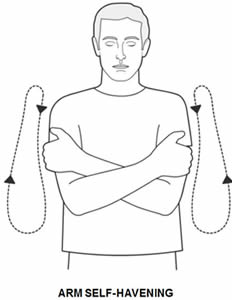 |
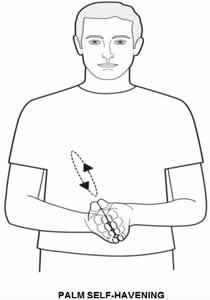 |
The following process is given as a guide for Self Havening:
- Activate the specific emotional event that you want to work on by thinking about it as if it is happening to you now. Once you have accessed the memory, rate your subjective unit of distress (SUD) level on a scale of 1-10, where 0 is not at all and 10 is extreme;
- Begin self-Havening by applying havening touch on the face, arms or palms with repetitive circular movements as shown in the diagram;
- At the same time, with your eyes closed, visualize walking up a flight of stairs counting out loud from 1-20 with each step. As you climb, imagine yourself becoming more calm and peaceful diminishing the distressing feelings exponentially;
- On reaching the count of 20, begin to hum a familiar tune such as twinkle, twinkle little star for a couple of rounds. As you continue applying havening touch on arms, face or palms take a deep breath in and point your eyes to the left and right whilst keeping your head straight and aligned with your spine. Close your eyes, inhale deeply and breath out on the count of 5 whilst still applying Havening touch and then rate your SUD to track how much the emotion has reduced;
- Repeat 2-4 with a different havening surface, either choosing the same visualization and counting from 1-20 and tune, or you can choose a different tune. Other visualizations include swimming, running, playing tennis etc. Continue repeating Havening rounds until your SUD is at 0.
Havening complements other methods of healing and personal development. Indeed, after successful havening, it is often necessary to help the client build a new identity through the process of coaching and Neurolinguistic programming technologies. Havening is that powerful such that clients can often be left feeling a little ‘lost’ as they become accustomed to new way of being. Therefore, coaching is highly recommended.
One such coach is Steve Crabb who is able to easily and effectively deal with many areas from business success to habit breaking and phobias. He has been a personal assistant to Paul McKenna for many years and has trained with the world’s leading coaches. I attended one of his seminars where I witnessed his ability to cure a lady of her fear of food such that she was able to eat a sandwich without any trouble during lunch; we all saw the amazing change in her demeanour Her eyes were sparkling and she looked much happier and peaceful. One of the side effects of havening is that people tend to feel lighter and look ten years younger. When you think about how stress ages people beyond their years and being able to literally ‘unplug’ those brain connections, you can see that this effect would make sense. For a full explanation of how havening impacts the chemical structures in the brain please refer to Dr Ruden’s book.
If you would like to find out more about practitioner training please visit www.havening.org .
References and Further Reading
Ruden.R. Dr. When the Past is Always Present. Taylor and Francis Group, LLC. United States of America. ISBN 978-0-415-87564-6. 2011.
UK Based Havening Practitioners trained by Dr Ronald Ruden
Therapists
Tony Burgess - www.ditchyourtrauma.co.uk/
Carol Robertson – www.justbewell.com
Coaches
Gina Pickersgill – www.ginapickersgill.com
Steve Crabb - www.stevecrabbcoachingexcellence.com
To experience havening for yourself contact the following practitioners
Steve Crabb - www.stevecrabbcoachingexcellence.com
Tony Burgess - www.ditchyourtrauma.co.uk/
Carol Robertson or Gina Pickersgill at - www.justbewell.com/
Comments:
-
No Article Comments available